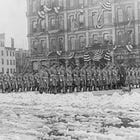Minor Modifications to the US Army Infantry Regiment (1943-1945)
Battalion: An Organizational Study of United States Infantry
Welcome to the Tactical Notebook, where you will find five hundred tales of armies that are, armies that were, and armies that might have been. If you like what you see here, please share the Tactical Notebook with your friends.
The estate of the late John Sayen has graciously allowed the Tactical Notebook to serialize his study of the organizational evolution of American infantry battalions. The author’s preface, as well as some previously posted parts of this book, may be found below, in the section marked “For Further Reading.”
Even when modified by the “revolt of the generals,” the reforms implemented by Lieutenant General Leslie J. McNair saved enough manpower to increase the number of infantry divisions raised by the US Army in 1943 and 1944 from sixty to sixty-six. When combined with favorable reports about the performance of the smaller infantry regiments in combat, this fact did much to diminish complaints from theater commanders and other senior officers. Thus, apart from a number of very minor changes, the tables of organization adopted on 15 July 1943 remained in force for the rest of the war.
In October 1943, a modification to the establishment of the service company provided that unit with an “assistant S-1 athletic and recreation officer.” Mandated by a War Department policy that applied to the Army as a whole, this seemingly senseless addition provided the regimental staff with a spare officer who, one might imagine, did things other than organizing baseball games.
On 26 February 1944, a new edition of the tables of organization of 15 July 1943, increased the ranks held by non-commissioned officers in leadership positions. Thus, the sergeants in charge of rifle squads and antitank gun squads became staff sergeants while the corporals leading machine gun and mortar squads became sergeants. Similarly, platoon sergeants who had been staff sergeants were promoted to the rank of technical sergeant.
The new correlation between the billet of platoon sergeant and the rank of technical sergeant deprived the latter of its original association with highly specialized duties. Similarly, the replacement of so many positions for corporals with slots for sergeants greatly reduced the number of corporals. Thus, for example, the number of soldiers in the weapons company of the infantry battalion authorized to wear the rank of corporal dropped from twenty-one to seven. In the rifle company, the number of jobs for corporals was reduced from fifteen to one. (The remaining corporal in the rifle company served as the company clerk.)
The tables of organization of 26 February 1944 also authorized the replacement of the M1903 rifles that had been used to fire rifle grenades with M1 rifles fitted with the new M7 grenade launcher.
On 30 June 1944, the War Department authorized the issue of additional automatic weapons to elements of the infantry regiment. Rather than being assigned to particular individuals, these weapons were designated as “spare” weapons, to be issued as needed at the discretion of company commanders. (Each rifle company got six additional Browning automatic rifles and six submachine guns. The headquarters company of each infantry battalion received six light machine guns and two submachine guns. )
For Further Reading:









